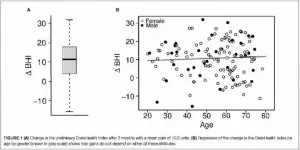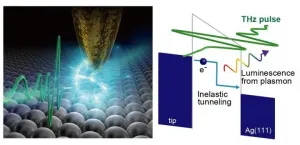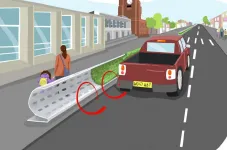Precision BrainHealth: Personalized measure, training protocols to impact global health
2021-03-09
DALLAS (March 9, 2021) - Better brain health and performance for humankind is one step closer to reality with the successful trial of the groundbreaking BrainHealth Project. A cross-disciplinary team with the Center for BrainHealth® at The University of Texas at Dallas unveiled an easy-to-use online platform that delivers a novel, science-backed approach to measuring, improving and tracking one's own brain fitness.
A key innovation of the Project centers on the BrainHealth Index™ (BHI), which is based on a multidimensional definition of brain health and its upward potential. The BHI is a composite derived from a series of best-in-class assessments that explore ...
Adaptation, not irrigation recommended for Midwest corn farmers
2021-03-09
Farmers in the Midwest may be able to bypass the warming climate not by getting more water for their crops, but instead by adapting to climate change through soil management says a new study from Michigan State University.
"The Midwest supplies 30% of the world's corn and soybeans," said Bruno Basso, an ecosystems scientist and MSU Foundation Professor in the Department of Earth and Environmental Sciences within the College of Natural Science. "These crops are sensitive to temperature and water changes."
Previous studies have suggested that by 2050, the Midwest will need about 35% more water to sustain its current levels of corn and soybean yields. But research done by Basso and colleagues found that the data does not support this idea. The Midwest is in a unique location that ...
Now is the time to study impact of pandemic on mothers and babies
2021-03-09
If past natural disasters have taught us anything about their effects on pregnant women and developing babies, it is to pay close attention, for the added stress will surely have an impact on them. Amanda Venta, associate professor of psychology at the University of Houston, is sounding that alarm as it relates to the COVID-19 pandemic in a newly released study published in Child Psychiatry & Human Development.
"There is strong evidence to suggest that the coronavirus pandemic will affect mothers and infants through immune pathways that, in previous research, have been shown to link stress and social isolation during the pre- and post-natal periods with deficits in maternal mental health and infant well-being and development across developmental stages," reports Venta.
Research ...
A little squid and its glowing bacteria yield new clues to symbiotic relationships
2021-03-09
The relationship between the Hawaiian bobtail squid and the bioluminescent bacteria living in its light organ has been studied for decades as a model of symbiosis. Now researchers have used a powerful chemical analysis tool to identify a small molecule produced by the bacteria that appears to play an important role in their colonization of the light organ.
The study, published March 9 in the journal mBio, adds a new wrinkle to scientists' understanding of the chemical signaling involved in this iconic symbiotic relationship. "It's exciting that there are still new things to discover, even in such a well-studied system," said corresponding author Laura Sanchez, associate professor ...
Study reveals new hope for men with common urinary issues
2021-03-09
A new systematic review of evidence recommends the use of behavioral self-management treatments for common urinary issues experienced by upwards of 70 percent of older men. Common symptoms include trouble urinating, increased frequency and incontinence. These symptoms can have a substantial negative impact on sleep, social functioning and quality of life. Several guidelines recommend self-management techniques like health education, advice on fluid intake, and bladder retraining; however, in practice, self-management is often excluded from the menu of treatment options that include medication and surgery.
Researchers at Bond University's Institute for Evidence-Based Healthcare found that self-management interventions reduced the severity of lower urinary tract symptoms. The ...
Microscopic wormholes possible in theory
2021-03-09
Wormholes play a key role in many science fiction films - often as a shortcut between two distant points in space. In physics, however, these tunnels in spacetime have remained purely hypothetical. An international team led by Dr. Jose Luis Blázquez-Salcedo of the University of Oldenburg has now presented a new theoretical model in the science journal Physical Review Letters that makes microscopic wormholes seem less far-fetched than in previous theories.
Wormholes, like black holes, appear in the equations of Albert Einstein's general theory ...
Treating incontinence in primary care: A doctor versus mobile app trial
2021-03-09
A mobile app designed to help women manage urinary incontinence was as effective as usual, in-person treatment of incontinence in primary care, according to new research from the Netherlands. The study included 262 women with frequent stress incontinence, overactive bladder or a mix of symptoms. Participants were randomly assigned to use a standalone mobile app called URinControl, which offered pelvic floor muscle and bladder training exercises. Those in a control group received standard care and were referred to their own primary care doctors who were broadly advised to follow the Dutch guidelines for primary care. After four months, ...
Microscope allows ultrafast nanoscale manipulation while tracking energy dynamics
2021-03-09
Since the early 2010s, ultrafast probing of materials at atomic-level resolution has been enabled by terahertz scanning tunneling microscopes (THz-STM). But these devices can't detect the dissipation of energy that happens during events such as when photons are emitted via recombination process of an electron-hole pair in a light emitting diode (LED). However, a new technique allows the tracking of just such energy dynamics alongside THz-STM, opening up new avenues of investigation for nanoscale science and technology.
Researchers in Japan have developed a microscopy technique that combines the ability to manipulate the motion of electrons on a femtosecond timescale ...
Perspectives of US youth during the initial month of the COVID-19 pandemic
2021-03-09
According to two national surveys by researchers at the University of Michigan Medical School, US teens and young adults are engaged in the ongoing COVID-19 pandemic with most being knowledgeable about the disease, concerned about its impacts on others, and practicing social distancing. On March 6, 2020, 70 percent reported knowledge of the pandemic, with 46 percent noting they got information from news sources. By March 20, 2020, nearly all respondents, 95 percent, reported impact. Worry about the pandemic increased from 25 to 51 percent. For some young people who weren't worried early on about the pandemic, staying at home and engaging in other preventive public health guidelines made them feel safer. Between the two surveys, pandemic preparation seemed to shift. ...
Cochrane Review finds stopping smoking is linked to improved mental health
2021-03-09
Evidence published in the Cochrane Library today will reassure people who want to stop smoking that quitting for at least 6 weeks may improve their mental wellbeing, by reducing anxiety, depression, and stress. People's social relationships are unlikely to suffer if they stop smoking.
Smoking is the world's leading cause of preventable illness and death. One in every two people who smoke will die of a smoking-related disease unless they quit. Some people believe that smoking helps reduce stress and other mental health symptoms, and that quitting smoking might make their mental health problems worse. People who smoke may also worry that stopping smoking will have a negative impact on their social lives and friendships.
The review found that people who stopped smoking for at least 6 weeks ...
New lung cancer screening recommendation expands access but may not address inequities
2021-03-09
CHAPEL HILL, NC -- Calling the U.S. Preventive Services Task Force's newly released recommendation statement to expand eligibility for annual lung cancer screening with low-dose computed tomography a step forward, UNC Lineberger Comprehensive Cancer Center researchers say future changes should address equity and implementation issues.
In an editorial published in JAMA, Louise M. Henderson, PhD, professor of radiology at UNC School of Medicine, M. Patricia Rivera, MD, professor of medicine at UNC School of Medicine, and Ethan Basch, MD, MSc, the Richard M. Goldberg Distinguished Professor in Medical Oncology and chief of oncology at the UNC School of Medicine, outlined their concerns and offered potential approaches to make the screening recommendation ...
Humidity in breath makes cotton masks more effective at slowing the spread of COVID-19
2021-03-09
Researchers have come up with a better way to test which fabrics work best for masks that are meant to slow the spread of COVID-19. By testing those fabrics under conditions that mimic the humidity of a person's breath, the researchers have obtained measurements that more accurately reflect how the fabrics perform when worn by a living, breathing person.
The new measurements show that under humid conditions, the filtration efficiency -- a measure of how well a material captures particles -- increased by an average of 33% in cotton fabrics. Synthetic fabrics performed poorly relative to cotton, and their performance did not improve with humidity. The material from medical-procedure masks also did not improve with humidity, though it performed ...
Gigantic jet spied from black hole in early universe
2021-03-09
Astronomers have discovered evidence for an extraordinarily long jet of particles coming from a supermassive black hole in the early universe, using NASA's Chandra X-ray Observatory.
If confirmed, it would be the most distant supermassive black hole with a jet detected in X-rays. Coming from a galaxy about 12.7 billion light-years from Earth, the jet may help explain how the biggest black holes formed at a very early time in the universe's history.
The source of the jet is a quasar - a rapidly growing supermassive black hole - named PSO J352.4034-15.3373 (PJ352-15 for short), which sits ...
Problematic internet use and teen depression are closely linked, new Concordia study finds
2021-03-09
Most teenagers don't remember life before the internet. They have grown up in a connected world, and being online has become one of their main sources of learning, entertaining and socializing.
As many previous studies have pointed out, and as many parents worry, this reality does not come risk-free. Whereas time on the internet can be informative, instructive and even pleasant, there is already significant literature on the potential harm caused by young children's problematic internet use (PIU).
However, a new study led by END ...
NYU Abu Dhabi study predicts motion sickness severity
2021-03-09
"It was clear that the greater an individual's sensitivity to motion parallax cues, the more severe the motion sickness symptoms," says lead NYU Abu Dhabi researcher
Fast facts:
The visual system is often studied in relative isolation, but it has clear connections to other components of the nervous system.
A notable example of this is motion sickness, which affects certain people much more severely than others.
Motion sickness is typically associated with traveling in cars, boats, and airplanes, however discomfort or "cybersickness" also arises with technological use such as in virtual reality (VR).
Abu Dhabi, UAE, March 9, 2021: A new study led by Head of the Rokers Vision Laboratory and NYUAD Associate Professor of Psychology Bas Rokers explored why ...
Detecting hidden circulating tumor cells in non-small cell lung cancer patients
2021-03-09
Non-Small Cell Lung Cancer (NSCLC) is the most prevalent form of lung cancer, accounting for more than 80 percent of all lung cancer cases. Despite the aggressive nature of NSCLC, circulating tumor cells that lead to metastases often go undetected in the blood compared to breast, prostate, colorectal, and other cancers.
Now, scientists have developed a novel method to better detect the circulating tumor cells (CTCs) that are a telltale sign of metastases. The research was published in the journal Proceedings of the National Academy of Sciences (PNAS).
ISB and a collaborative team of researchers looked at hexokinase-2, or HK2, a ...
Researchers develop roadside barrier design to mitigate air pollution
2021-03-09
A unique curved barrier has been designed by researchers at Imperial College London, who publish new findings in the peer-reviewed journal END ...
Use of patient data guides outreach to treat and monitor people with diabetes
2021-03-09
Researchers from the HealthPartners Institute and University of Minnesota in Minneapolis conducted an observational analysis of interviews and characteristics of primary care clinics, comparing the strategies, facilitators and barriers to high performance in treating patients with diabetes. The purpose of the study was to learn what strategies and factors seem most important to leaders of primary care clinics to ensure high performance. The percentage of Minnesota diabetes patients who achieved optimal diabetes care measures increased from 12 to 45 percent between 2004 and 2017, while national measures of diabetes care outcomes did not improve significantly around the same time ...
Researchers see need for warnings about long-range wildfire smoke
2021-03-09
Smoke from local wildfires can affect the health of Colorado residents, in addition to smoke from fires in forests as far away as California and the Pacific Northwest.
Researchers at Colorado State University, curious about the health effects from smoke from large wildfires across the Western United States, analyzed six years of hospitalization data and death records for the cities along the Front Range, which reaches deep into central Colorado from southern Wyoming.
They found that wildfire smoke was associated with increased hospitalizations for asthma, chronic obstructive pulmonary disease and some cardiovascular health outcomes. They also discovered that wildfire smoke was associated with deaths from asthma and cardiovascular disease, but that ...
A liquid crystal walks into an optical resonator: new Skoltech research helps model future optoelect
2021-03-09
Researchers at Skoltech and their colleagues proposed a photonic device from two optical resonators with liquid crystals inside them to study optical properties of this system that can be useful for future generations of optoelectronic and spinoptronic devices. The paper was published in the journal Physical Review B.
The simplest kind of optical resonator consists of two mirrors directly opposite each other, "squeezing" light between them. When you stand inside a mirror resonator, you see infinite copies of yourself in the mirrors; when a liquid crystal - the kind in your computer and smartphone screen - is placed into a much smaller and a bit more complex resonator, ...
More collaboration between primary care and oncology may improve fragmented cancer care
2021-03-09
Cancer patients often experience fragmented care, particularly as they undergo cancer treatments. Although family physicians seek to provide continuous and comprehensive care, they often lose touch with their cancer patients during the treatment phase. Researchers conducted a randomized intervention that aimed to improve continuity of care and interprofessional collaboration as perceived by lung cancer patients and their family physicians.
The components of the intervention included the bidirectional exchange of patient information and care summaries between oncology teams and family physicians. Oncology ...
Floral probiotics reduce apple disease
2021-03-09
While many celebrate apple blossoms as classic signs of spring, they are also welcoming entry gates for pathogens. Full of nutrients to lure pollinators and promote pollen germination, flowers also attract bacteria like Erwinia amylavora, a pathogen that causes a damaging disease called fire blight. However, recent work by scientists at the Connecticut Agricultural Experiment Station suggests that these flowery infection sites might also be perfect targets for applying microbial fire blight biocontrol measures.
In a paper recently published in Phytobiomes Journal, researchers Zhouqi ...
LJI research leads to promising combination therapy for type 1 diabetes
2021-03-09
LA JOLLA, CA--Translational research led by scientists at La Jolla Institute for Immunology (LJI) has resulted in a promising combination therapeutic candidate for adults with recent-onset type 1 diabetes.
The combination therapy was recently tested in a randomised, double-blind, placebo-
controlled, phase 2 trial run and funded by pharmaceutical company Novo Nordisk. The results, published recently in The Lancet Diabetes and Endocrinology, point to a potential way to treat the autoimmune disease without leaving the body vulnerable to infectious disease.
The therapeutic candidate combines anti-IL-21 antibody with the diabetes drug liraglutide. This ...
Unconscious biases can drive foodborne illness outbreaks, MU researchers find
2021-03-09
COLUMBIA, Mo. - In the midst of a pandemic that has claimed more than 2 million lives worldwide and disrupted nearly every facet of society since it appeared more than a year ago, understanding the factors that create and facilitate disease outbreaks is more important than ever. Now, researchers at the University of Missouri have determined that cognitive biases -- patterns of errors in thinking that affect judgments and behaviors, often unconsciously -- can help create and worsen foodborne disease outbreaks.
"Unethical behavior isn't always intentional; conflicts of interest and other unconscious motivations can lead people to behave ...
NIH scientists use human cerebral organoid to test drug for deadly brain disease
2021-03-09
WHAT:
Approximately two years after establishing a human cerebral organoid system to study Creutzfeldt-Jakob disease (CJD), National Institutes of Health researchers have further developed the model to screen drugs for potential CJD treatment. The scientists, from NIH's National Institute of Allergy and Infectious Diseases (NIAID), describe their work in Scientific Reports.
Human cerebral organoids are small balls of human brain cells ranging in size from a poppy seed to a pea; scientists use human skin cells to create them. CJD, a fatal neurodegenerative brain disease of humans caused by infectious prion proteins, affects about 1 in 1 million people each year. It can arise spontaneously, result from ...
[1] ... [2432]
[2433]
[2434]
[2435]
[2436]
[2437]
[2438]
[2439]
2440
[2441]
[2442]
[2443]
[2444]
[2445]
[2446]
[2447]
[2448]
... [8705]
Press-News.org - Free Press Release Distribution service.














